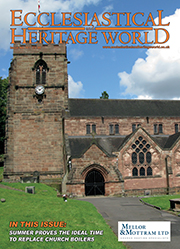Archaeological Exhumation with Respect for Funeral Traditions
 Surprising Discoveries during Exhumations Of A Post Medieval London Cemetery
Surprising Discoveries during Exhumations Of A Post Medieval London Cemetery
Church buildings are often found to be sites of hidden historical and archaeological interest writes Mark Toop, who has made a number of unusual and significant discoveries in his role as Exhumations Director at Rowland Brothers Funeral Directors. Here he reminisces over such instances during a lifelong career.
Mark Toop has worked alongside architects and archaeologists throughout his professional life. Arguably, one of the most important discoveries in which he was involved, was that of the grave of evangelist Rev Charles Wesley and his family.
 In 2004, Mark had been approached by developers about plans for an underground indoor sports facility at St Marylebone Church of England School in central London. Building projects sometimes reveal extraordinary finds, but with plans to develop a school playground, the architects could not have imagined the wealth of social history which lay hidden beneath it.
In 2004, Mark had been approached by developers about plans for an underground indoor sports facility at St Marylebone Church of England School in central London. Building projects sometimes reveal extraordinary finds, but with plans to develop a school playground, the architects could not have imagined the wealth of social history which lay hidden beneath it.
The playground occupied the site of an ancient burial ground belonging to the church of St Marylebone, and the building which replaced it in the 18th century. In the 18th century, the parish of St Marylebone was one of the wealthiest in London and by 1742, the congregation had outgrown the parish church. So, a much grander version was built on the Marylebone Road in 1817.
Fast forward to the 1930’s, and the graveyard of the 18th century church was levelled to create a playground for St Marylebone Church of England Girls School.
Then, in 2004, plans to build an underground sports hall resulted in excavation of a sample area of the burial ground and the church. The work became one of the largest and most comprehensive studies of a post medieval London cemetery.
Mark takes up the story: “As in many excavation sites, this one was in a busy area. We were close to a high street and a school. Our priority as always was the dignity and privacy of the deceased. The entire area was screened off, and covered by a temporary scaffolding roof. Before we began our work, we arranged a suitable religious service which was conducted at the site. The area was then covered with an alpha numeric grid, so we could record the location of the burials. Working alongside the archaeologists, the burials were excavated and exhumed individually.
In sites of this age, the wooden coffins have rotted away but lead coffins often remain intact. Personal details inscribed on the coffin breastplates were recorded, and any other coffin furniture was retained. The social history uncovered at the site was extraordinary. One of the graves was identified as that of Rev Charles Wesley and his family – his wife Sarah , their son Charles and Sarah’s sister Rebecca. They were re-interred in the Church, but all the other burials took place in the City of London cemetery”.
A fascinating selection of personal items was recovered from the Marylebone site, including buttons, jewellery, an umbrella, and even 19th century dentures carved from ivory. The Museum of London catalogued and published all these finds, linking the details of the deceased with local records, exploring burial practices at the time and drawing remarkable conclusions about the local community and mortality rates.
Mark points out that, from a historical point of view, the excavation of an ancient burial site is both humbling and fascinating. From a commercial point of view, the unexpected discovery of a grave can cause lengthy and expensive delays, while licenses are obtained for the exhumation, notices are placed in newspapers, archaeologists are consulted, and plans are made for reburial, usually at the developer’s expense.
Often, developers know that they are working in an area where they may find a grave - for example, near a school, church, hospital, even on an ancient battlefield. Well known parts of London where Mark has worked include the Barbican, Commercial Road, Stonecutter Street and St Andrews Crypt in Holborn. He has also worked with the World Health Organisation overseas, researching the deaths of men who died in the Spanish flu epidemic in 1918.
However, Mark is most often appointed by architects or archaeologists who respect how his experience in the building trade helps to identify structural issues on site, while his experience in funeral direction guarantees respect for funeral traditions.
If you would like to find out more about the relationship between exhumation and land development, please email Mark at Rowland Brothers - This email address is being protected from spambots. You need JavaScript enabled to view it.
















